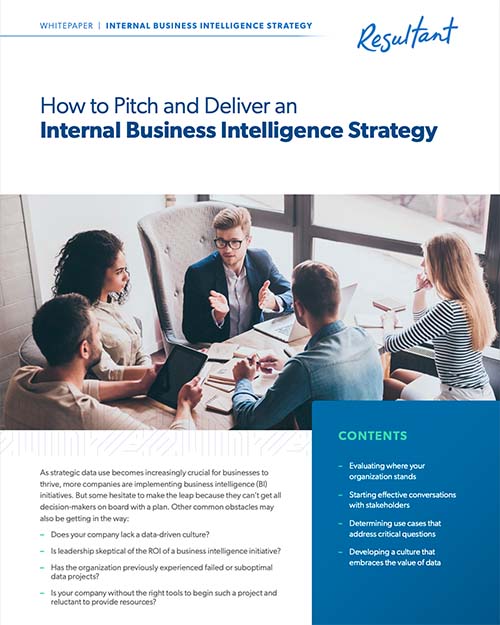Introduction
The Sell
1. Reinforce quick wins.
A quick assessment of the BI strategy or proof of concept (POC) will show leadership how it can deliver quick wins for the company. Demonstrating the value BI provides within a short time frame via a pilot implementation before full-scale change allows everyone to realize benefits with minimal risk.
2. Ease any concerns.
Reassure leadership that a BI implementation isn’t all or nothing—they don’t have to entirely reconfigure or replace every single existing strategy and process. Organizations today al- ready use multiple tools within daily operations, and BI is no different. Even a full-scale project will come online in stages, each utilizing a different tool. Emphasizing the timeline and iterative aspect of an implementation can help assuage many concerns about risk.
3. Determine scope and success.
When leadership is receptive to the idea that BI strategy is worth trying, define the scope and determine what would make a pilot successful. Keep the scope sized appropriately to your company. For example, the time period for a single department trying out data visualization software might be a couple of weeks; a large enterprise auditioning a complex platform might take a few months. It’s all about finding the right balance between showing value and the price point.
4. Define use cases.
Once leadership is sold on the pilot, set up a charter for it and define the approval process upfront. Stay current on project happenings and report them to stakeholders. When it’s time to present results upstream, provide detailed costs and show turnaround time, what specific business challeng- es the BI strategy solves, and—most importantly—the ROI this BI implementation will provide the organization.
5. Communicate success.
The most critical step of the process is to continuously and clearly communicate the success BI strategy can provide. Deliver as much detailed information as necessary to ensure leadership is comfortable with the rollout plan post-pilot. Including outside expert guidance and training in your plan will give them additional confidence that the BI strategy will be optimized for maximum benefit to the organization.
6. Seek help from a consultant.
While you can effectively sell a BI strategy upstream using the above steps, partnering with business intelligence consultants can expedite the process and give leadership even more assurance about implementation. For example, if you execute a pi- lot without external resources, internal team member skillsets determine the value generated. But when you engage outside expert assistance from Resultant you gain access to:




